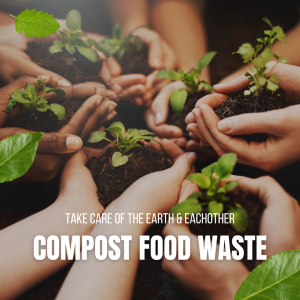Each April, we celebrate Earth Month. Did you know that the average U.S. household wastes nearly a third of the food it buys?
 In Susan Shain’s article for the New York Times, she shares that households “account for 39 percent of food waste in the United States, more than restaurants, grocery stores or farms. Change, then, means tackling the hard-wired habits of hundreds of millions of individuals, community by community, home by home.”
In Susan Shain’s article for the New York Times, she shares that households “account for 39 percent of food waste in the United States, more than restaurants, grocery stores or farms. Change, then, means tackling the hard-wired habits of hundreds of millions of individuals, community by community, home by home.”
Composting food waste is a great way to reduce the amount of waste in landfills while creating a nutrient-rich soil that you can use for gardening or farming. Composting also supports the well-being of our community and gives us a reason to get outside for fresh air year-round.
Here are the basic steps if you are interested in composting:
- Choose a composting container. You can use a compost bin, compost tumbler or create your own compost pile.
- Collect your food waste. Collect your fruit and vegetable scraps, eggshells, coffee grounds, tea bags and other food waste in a separate container.
- Add brown materials. To create the right balance of carbon and nitrogen, add brown materials such as dry leaves, twigs, shredded paper or sawdust to the compost bin or pile.
- Add water. Keep the compost moist but not too wet. Water the compost occasionally to maintain the right level of moisture.
- Mix and turn. To speed up the composting process, mix the compost pile or turn the tumbler every few days to ensure that all the materials are breaking down evenly.
- Wait for the compost to mature. Depending on the composting method, the compost can take anywhere from a few weeks to several months to mature. Once it has matured, it will be a rich, dark soil that you can use to fertilize plants and enrich garden soil.